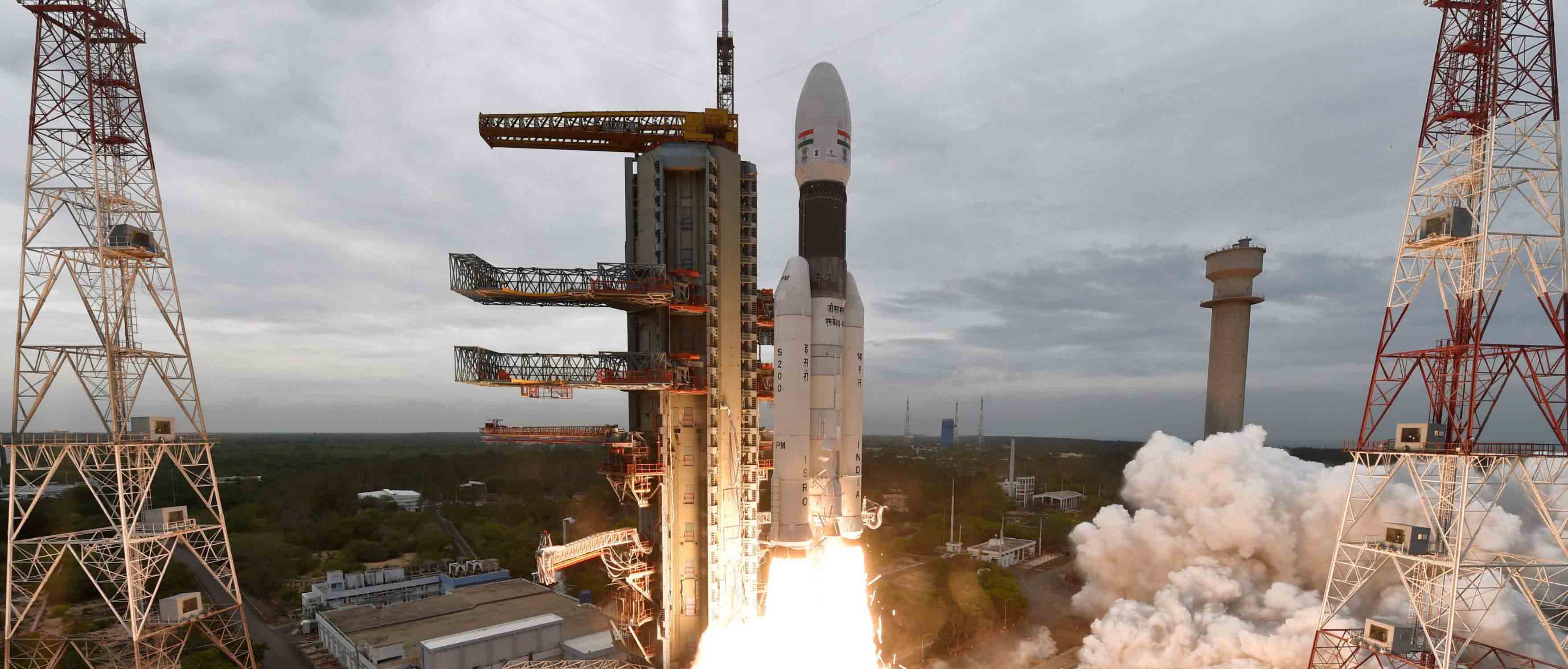Project Chandrayan- Reaching for the Moon
October 7, 2019 | Expert Insights

Background
Indian space odyssey is a story of rags to riches. With a humble start which saw aspiring space scientists transporting rudimentary rockets on bicycles for launch amidst the coconut plantations of Thumba in Trivandrum, Indian Space Research Organisation (ISRO) has come a long way. Its Project Chandrayan-II came tantalisingly close to remotely land an unmanned spacecraft on the lunar surface. Chandrayaan-II was preceded by Chandrayaan-I which in 2008 crash-landed on the moon and sent analysis indicating presence of water.
Chandrayaan-II was boosted into space on a GSLV rocket on July 22nd and has an orbiter and a lander (Vikram- named after the doyen of the Indian space programme- Vikram Sarabhai) which carries a rover (Pragyan). Scheduled to soft-land on moon’s south polar region on September 6th, the lander deviated from its programmed trajectory during the final phase of descent, lost communications and is presumed lost. The orbiter is reported to be performing as per its design parameters.
If Vikram had made a safe landing, it would have placed India amongst the three countries that have done this successfully- US, Russia and China. Israel’s lunar landing also failed earlier in April under almost similar circumstances.
The Chandrayan-2 project was initiated in 2007 in collaboration with the Russian Federal Space Agency (Roscosmos). Chandrayan-I cost approximately Rs 386 crore while Chandrayan-II had been budgeted for Rs 978 crore.
ISRO’s next ambitious space project is Project Gaganyan in which it plans to send Indian astronauts into orbit by 2022. Shortlisting of potential candidates is already in progress and their training is likely to be conducted with Russian assistance.
Analysis
The question which begs an answer is can India afford the luxury of dabbling in costly space ventures with a ranking of 130 out of 189 countries in the latest human development rankings released by the United Nations Development Programme.
As per ISRO handouts, Chandrayan mission objective was to validate Indian technical capability to soft land on lunar surface and conduct explorations and host of scientific experiments with the rover.
Mlswamy Annadurai, former ISRO scientist and Project Director for Chandrayaan-I and Mangalayaan, was quoted in the media as stating, “This is important for various reasons.... It could be exploring the South Pole, attempting soft landing or imprinting India's tricolour on the moon for centuries to come”. Justifying the cost to benefit ratio, he said, ”At a modest budget of about Rs 390 crore, it (ChandrayaanI) discovered water on the moon, a path-breaking discovery then. In retrospect, the cost is much lower than the marketing budgets of big companies. Even in this (Chandrayaan-II), only Rs 100 crore went into the mission and the rest went into upgrading the existing infrastructure, which is currently being used for other missions as well."
The space remains an unexplored frontier. Human genius is not beyond coming up with the means in the future to mine/ farm planets far from Earth. There are already corporations in the US who are in real earnest developing appropriate technology. Though India is far from reaching this level, ISRO maintains that such missions are but stepping stones towards future capacity building.
Counterpoint
Critics of the Indian Space programme decry the fact that a country which trails behind all indices of human development, is spending millions on rocketry that contributes little to the GDP in terms of any tangible benefits apart from an occasional outpouring of national pride.
Often the example of such advanced countries like Germany, France and Japan is cited who definitely have the technological capacity but refrain from space ambitions believing it not worth the cost for the national exchequer.
Economy, which actually lays foundation for national power, benefits from mass-marketed technologies which sell at great premium - civil aviation, Internet Computer Technology (ICT) to name a few. Niche technologies like space on the other hand have limited commercial value and add little to the national treasure.
- Space exploration is glamourous, makes for excellent showcasing of one’s scientific and technological progress and perhaps this is the reason that it has received bipartisan support from all political parties.
- India has maintained research stations in Arctic and Antarctica for long to remain involved and be in a position to participate in future commercial exploration of these frozen continents. Perhaps ISRO is working on a similar logic with the promise that someday in the future the investment will turn out to be a hugely profitable endeavour.
- Space is projected to be big business with even private players like Space X spending billions. Indian satellite launch capability has been commercially in use. We can only hope that the precious resources which India continues to invest in its space programme will pay the country rich dividends in times to come.
Image Courtesy: wikimedia commons








Comments